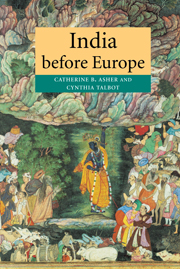Book contents
- Frontmatter
- Contents
- List of illustrations
- List of maps
- Preface
- Glossary
- Place names: alternative spellings
- 1 Introduction: situating India
- 2 The expansion of Turkic power, 1180–1350
- 3 Southern India in the age of Vijayanagara, 1350–1550
- 4 North India between empires: history, society, and culture, 1350–1550
- 5 Sixteenth-century north India: empire reformulated
- 6 Expanding political and economic spheres, 1550–1650
- 7 Elite cultures in seventeenth-century South Asia
- 8 Challenging central authority, 1650–1750
- 9 Changing socio-economic formations, 1650–1750
- Epilogue
- Biographical notes
- Bibliography
- Index
9 - Changing socio-economic formations, 1650–1750
Published online by Cambridge University Press: 05 June 2014
- Frontmatter
- Contents
- List of illustrations
- List of maps
- Preface
- Glossary
- Place names: alternative spellings
- 1 Introduction: situating India
- 2 The expansion of Turkic power, 1180–1350
- 3 Southern India in the age of Vijayanagara, 1350–1550
- 4 North India between empires: history, society, and culture, 1350–1550
- 5 Sixteenth-century north India: empire reformulated
- 6 Expanding political and economic spheres, 1550–1650
- 7 Elite cultures in seventeenth-century South Asia
- 8 Challenging central authority, 1650–1750
- 9 Changing socio-economic formations, 1650–1750
- Epilogue
- Biographical notes
- Bibliography
- Index
Summary
The beginnings of the Mughal empire's eventual demise can be traced back to the reign of Aurangzeb in the late seventeenth century. His preoccupation with the Deccan wars and the consequent loss of morale among the nobility are two important causes of the weakening of empire, leading by the mid eighteenth century to the dismemberment of Mughal territory into numerous smaller states. In this chapter, we cover additional reasons for the political instability that engulfed the empire following Aurangzeb's death. As the empire disintegrated, local elites and communities sought, and in many cases were able to obtain, more autonomy and control over their own affairs. Each region had a different experience in the aftermath of empire, however, not only politically but also economically, with some regions faring far better than others. Events in the Bengal area were especially wrought with significance for the subsequent history of the subcontinent, for it was there that the English first obtained an extensive foothold within the internal affairs of the erstwhile empire. We therefore both begin and end this chapter with an account of the activities of the European trading companies, whose long-term effect on Indian history was so disproportionate to their numbers and even to their immediate impact on the era from 1650 to 1750.
The European trading companies
The Dutch and English trading companies, who had begun their activities in India at the outset of the 1600s, made a major contribution to the Indian economy by supplying the bullion that enabled the twin trends of monetization and commercialization to gather steam.
- Type
- Chapter
- Information
- India before Europe , pp. 256 - 286Publisher: Cambridge University PressPrint publication year: 2006



